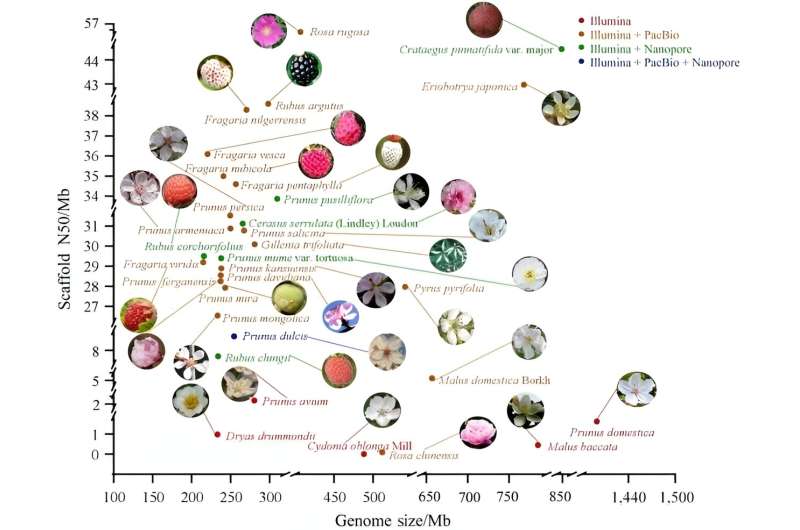This article has been reviewed according to Science X's editorial process and policies. Editors have highlighted the following attributes while ensuring the content's credibility:
fact-checked
trusted source
proofread
Advances in omics research of Rosaceae

A research team has provided a comprehensive overview of the applications of omics technologies in Rosaceae plants. The study highlights significant advancements in genome sequencing, transcriptome, proteomics, and metabolomics, shedding light on the genetic regulatory mechanisms underlying crucial traits such as flower color, fragrance, stress tolerance, and fruit quality.
This research is invaluable for molecular breeding and improving economic traits in Rosaceae plants, potentially leading to the rapid cultivation of new varieties and germplasm.
The Rosaceae family, with its diverse species and economic importance, is a focus of breeding efforts aimed at enhancing stress tolerance and ornamental and fruit qualities. Understanding the genetic basis of traits like flower color and fruit quality is essential for both consumer appeal and health benefits.
Despite challenges such as climate change-induced stresses, omics technologies, especially genomics, offer promising pathways for uncovering molecular mechanisms and developing resilient varieties.
A review article published in Ornamental Plant Research on 6 May 2024 reveals that multi-omics joint analysis has been instrumental in elucidating the complex genetic and biochemical networks regulating important traits in Rosaceae plants.
The study presents a comprehensive exploration of the application of different omics technologies in Rosaceae research. Genome sequencing has been crucial in identifying key genes for important traits. Thanks to continuous advancement of sequencing technology and splicing algorithms, many Rosaceae plants, like persica and Rubus occidentalis, have undergone genome resequencing, aiding comparative genomics and the discovery of high-quality genes for further study.
In addition, Genome-wide association studies (GWAS) is an effective research strategy for identifying genes/loci associated with complex traits in Rosaceae plants, such as flower color, fruit quality, and stress resistance.
Transcriptome analysis has been instrumental in studying gene expression dynamics, particularly during pivotal developmental stages or in response to stress. For example, analyzing the transcriptome of petals at various developmental stages has provided valuable insights into the biosynthesis of anthocyanins, pivotal for determining flower color.
In parallel, proteomics has delved into the diverse functional characteristics of cellular proteins. By identifying proteins associated with stress responses, flower coloration, and fruit quality, proteomic studies have offered fresh perspectives on regulating these traits.
Moreover, metabolomics has served as a bridge between genes and observable characteristics by examining changes in metabolites. Through metabolomic studies, researchers have unveiled the roles of different metabolites in stress responses and the quality attributes of Rosaceae fruits and flowers.
This review emphasizes the continuous advancement of omics technologies and their integration for a comprehensive understanding of complex traits in Rosaceae plants.
The integration of genomics, GWAS, transcriptomics, proteomics, and metabolomics has enabled the construction of detailed genetic regulatory networks, offering new insights into the growth, development, and stress responses of Rosaceae plants.
Looking ahead, the application of emerging technologies such as single-cell RNA sequencing (scRNA-seq) and spatial multi-omics will further enhance our understanding of cellular heterogeneity within plant tissues.
These technologies will allow for more precise gene expression and metabolic analysis at the single-cell level, providing a deeper understanding of the molecular mechanisms driving important traits in Rosaceae plants.
According to the study's researcher, Lidan Sun, "We outline the prospects of genomics research in Rosaceae plants, aiming to establish a foundation for comprehending the genetic mechanisms of molecular breeding and significant ornamental traits."
In summary, the future of Rosaceae plant research looks promising, with ongoing advancements in omics technologies paving the way for innovative breeding programs and the rapid development of new varieties with enhanced traits.
This research not only advances scientific knowledge but also has practical implications for agriculture and horticulture, ultimately contributing to the improvement of economically significant plants.
More information: Wenjuan Lv et al, Advances in the omics research of Rosaceae, Ornamental Plant Research (2024). DOI: 10.48130/opr-0024-0011
Provided by Chinese Academy of Sciences




















